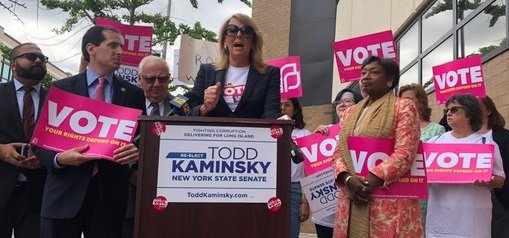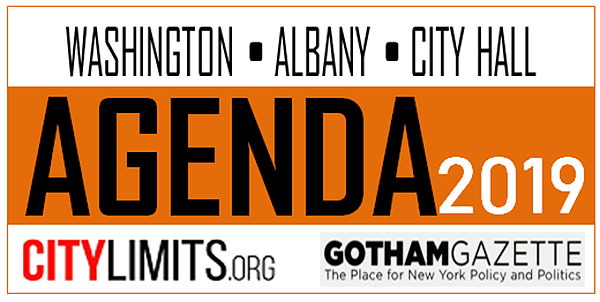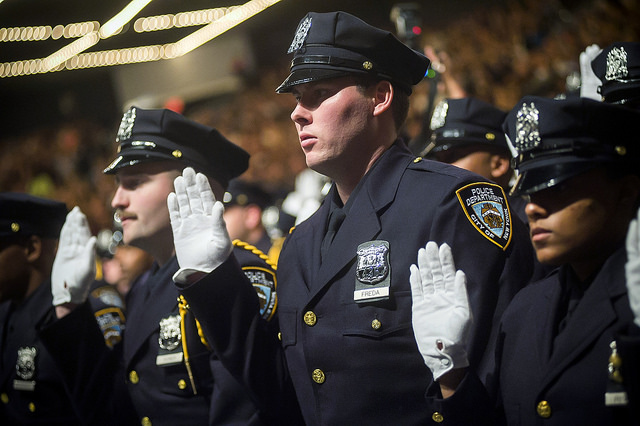New York Votes for a State Senate that Trusts Women

(photo: @PPESVotesPAC)
This is part of AGENDA 2019, a joint Gotham Gazette-City Limits project
Find the rest of the series here
For years reproductive health advocates have pushed to update New York’s antiquated abortion law and increase access to affordable contraception, only to be stalled by our state Senate leadership’s refusal to consider any reproductive health legislation. That roadblock continued despite the federal administration's efforts to drastically alter our reproductive health care - including our constitutional right to safe, legal abortion.
This November, voters turned out in larger-than-usual numbers for state Senate candidates who trust women to make their own health decisions - because the clear majority of New Yorkers understand our autonomy relies on our ability to control our own reproductive health care.
New York voters consistently support access to abortion. According to a July Quinnipiac poll, 73% of New York voters agree with U.S. Supreme Court's Roe v. Wade decision establishing a woman's right to access abortion care.
However, the state Senate majority leadership refused to consider the will and values of New Yorkers. During the election, we saw the same old rhetoric to shame and stigmatize women and their providers. But we also saw an energized electorate in New York and across the nation that trusts women, supports women, and believes that everyone should have equal access to health care.
You can outlaw safe, legal abortion, but you can’t legislate away the need. More than one-in-four women receive abortion care before age 45, and 59 percent of women who obtain an abortion already have at least one child. That’s your mom, your friend, your sister, or your fellow commuter on the train.
 While approximately 90 percent of abortions happen in the first 12 weeks of pregnancy, serious complications can arise at any time during pregnancy. Providing access to needed abortion care throughout pregnancy simply ensures proper medical care for those who require it.
While approximately 90 percent of abortions happen in the first 12 weeks of pregnancy, serious complications can arise at any time during pregnancy. Providing access to needed abortion care throughout pregnancy simply ensures proper medical care for those who require it.
Our current laws restrict our ability to access abortions to safeguard our health and fail to consider complications throughout pregnancy. Voters saw this clearly even if the Senate leadership refused to.
Now we have a state Senate that will truly represent women, not one that seeks to control them. We expect real progress, including protecting our right to abortion in our state law and keeping essential reproductive health care accessible to all New Yorkers.
In 2019, the voices of all New Yorkers will clearly be heard, not only in the streets but in the legislative chambers. That’s a trend we expect to see continue in our state and across the nation as voters realize that they can create the change they demand by casting a ballot.
This is part of AGENDA 2019, a joint Gotham Gazette-City Limits project
Find the rest of the series here
***
Robin Chappelle Golston is the Chair of Planned Parenthood Empire State Votes. On Twitter @PPESVotesPAC.
***
Have an op-ed idea or submission for Gotham Gazette? Email This email address is being protected from spambots. You need JavaScript enabled to view it.
The Right to Know is Law – Will the NYPD Abide by It?

(photo: Ed Reed/Mayor's Office)
This is part of AGENDA 2019, a joint Gotham Gazette-City Limits project
Find the rest of the series here
New York City recently took an important step toward police reform. The long-anticipated Right To Know Act has officially gone into effect, with important provisions dictating police-civilian encounters. The Act includes critical laws that will help end unconstitutional searches and require that police officers both identify themselves and provide the reason for an encounter – even leaving a business card in certain interactions.
After years of fighting for these reforms, we can start to rebuild the broken trust New Yorkers have in the NYPD by bringing more transparency and accountability to everyday interactions. But to do this, we need full and immediate cooperation from the NYPD and the Mayor’s Office.
The consent to search law will change the way certain police searches are conducted to help end unconstitutional searches. The new law requires that when there is no legal justification for a personal, home, or vehicle search (like a warrant or probable cause), NYPD officers must explain to the person they would like to search that they have a right to refuse the search, and their consent to the search has to be documented.
The NYPD identification law will require officers to provide basic information to the person they’re interacting with in writing, including the officer’s name, rank, command, and a phone number to be able to submit complaints or comments if no arrest is made, as well as a specific reason for the interaction. Interactions that are covered by the law include street stops, home searches, most roadblock and checkpoints, and questioning of crime survivors and witnesses.
Many people reading this might assume that such basic information provision is already a part of our policing system. But these steps were previously absent from law, which has resulted in serious problems.
This legislation is a vital part of restoring accountability and transparency in the NYPD, thus keeping communities, especially communities of color, safe from the harmful and abusive policing they are subjected to on a regular basis.
The Right To Know Act is a milestone not only for its content, but for also for its origins. This legislation started with community members impacted by police abuses and is the result of action from more than 200 organizations involved in Communities United for Police Reform (CPR). The charge in the City Council was led fearlessly by many Council members who also felt that the problem was personal to all New Yorkers.
Our advocacy was inspired by those who have been devastated by the status quo. Mothers like Constance Malcolm and Gwen Carr, who lost their children to police violence, gave us hope in their willingness to demand action. Now, children coming home from school will know that the police are not permitted to scare them, like by forcing them to open their bookbags and display the contents without reason.
But too often our work faced significant pushback from those most critical to our success, including our mayor, who has promised time and again to improve safety and police-community relations, and leaders of the NYPD. The Mayor’s Office scheduled a hearing for the Right To Know Act on the evening that Erica Garner was buried – knowing full well that many critical advocates wouldn’t be able to attend.
 The NYPD has missed countless opportunities to engage with CPR on how the Act would be implemented – in fact the department didn’t meet with us until last month, violating the law’s provision that community be consulted in advance of creating guidance and implementation. It has since refused to make any of the necessary changes to its internal guidance to officers that would bring them in compliance with the Right To Know Act and help ensure our communities’ rights are protected. Department leaders then turned around and said that we had “unprecedented” access to materials, and that they had already consulted with the community. This was untrue. And as the bill went into law, a Patrolmen's Benevolent Association spokesperson even referred to reform as a “burden” on officers.
The NYPD has missed countless opportunities to engage with CPR on how the Act would be implemented – in fact the department didn’t meet with us until last month, violating the law’s provision that community be consulted in advance of creating guidance and implementation. It has since refused to make any of the necessary changes to its internal guidance to officers that would bring them in compliance with the Right To Know Act and help ensure our communities’ rights are protected. Department leaders then turned around and said that we had “unprecedented” access to materials, and that they had already consulted with the community. This was untrue. And as the bill went into law, a Patrolmen's Benevolent Association spokesperson even referred to reform as a “burden” on officers.
Those kinds of comments undermine the gravity of this law and hardly inspire confidence in the NYPD’s willingness to honor and uphold its effective implementation. NYPD materials still lack clear, coherent language on some of the details required for police to implement the law. And there is mounting evidence that the NYPD is hardly trying to implement the bill in its entirety. It’s crucial that the NYPD and Mayor de Blasio focus on implementing and enforcing the Right to Know Act properly, and provide guidance and materials needed to ensure that NYPD officers follow these new laws. But regardless of their actions, CPR is prepared to educate citizens on their right to know in order to ensure that the NYPD does not violate or obstruct that right.
While the law going into effect is certainly something to celebrate, we clearly have much more work to do. The final version of the police identification bill included numerous carve-outs and exclusions that were universally opposed by the Right to Know Act coalition of more than 200 organizations. This legislation is one step of many in the path to true safety and justice for all New Yorkers. Passing reform-oriented legislation is crucial, but we must also critically examine and abolish harmful and unjust legislation. For instance, laws like ‘50A,’ which continues to protect the officers who killed Eric Garner, need to be repealed to achieve the goal of full transparency.
Today, the Right To Know Act is a symbol of the work we have done, but also of how far we still have to go. We are grateful to the community and the City Council, to New Yorkers for raising their voices, and to those who will continue to speak out against unnecessarily harsh policing. Together, we’ve made history. Let’s continue to do so.
This is part of AGENDA 2019, a joint Gotham Gazette-City Limits project
Find the rest of the series here
***
Monifa Bandele is a member of the steering committee for Communities United for Police Reform. She is also Senior Vice President and Chief Partnership & Equity Officer at MomsRising. On Twitter @monifabandele.
***
Have an op-ed idea or submission for Gotham Gazette? Email This email address is being protected from spambots. You need JavaScript enabled to view it.
New Yorkers Decided They Want More Democracy, But What Does That Mean?

(photo: John McCarten/City Council)
On Election Day, New Yorkers passed three ballot measures intended to strengthen local democracy. One of the approved plans is for the city to create a Civic Engagement Commission that will have several key responsibilities, including a new citywide participatory budgeting (PB) program, assistance to city agencies and nonprofits for their engagement efforts, and support to community boards to make them more participatory and representative of the communities they serve.
The passage of these ballot measures -- which also include lowering campaign contribution limits and instituting term limits on community board members -- is in line with a larger trend taking place across the country and the world. Citizens want more responsive governments. People want more choices, more information, and more of a say. While the new commission gives some local definition to this broader impulse and will be tasked with implementing the aforementioned changes, among other tasks, New Yorkers should also be aware of key issues and questions facing the commission.
First, citywide PB could take several forms. Up until now, it has been a district-based process, where City Council members engage their constituents in deciding how to spend roughly $1 million to improve their community. However, under the ballot measure, PB would be implemented citywide, making New York the first major United States city to do so. While the undertaking is a notable one, several questions arise.
Should this process allow citizens to provide input on the entire city budget, generate ideas for a special central fund, or both? Should it follow the example of the Paris PB process, which relies on digital crowdsourcing and voting, or also include the face-to-face meetings that have been part of PB in Brazilian cities (and New York City Council districts)? Research has shown that in many places, PB has had positive impacts in reducing poverty, improving public health, and raising trust in government – but which PB strategies would best help achieve those impacts here?
Second, helping agencies and nonprofits collaborate in their engagement efforts is both a laudable task and a complicated one. Various organizations and city departments define engagement very differently: for some it means encouraging volunteerism, for others it means advocacy and community organizing, and for still others it simply means disseminating information. Partly because there is no common definition of engagement, there are no commonly used metrics or tools for measuring, tracking, or benchmarking it.
New Yorkers are often not clear on what they’re being asked to engage in and why it is important. The new commission could create a coherent, comprehensive system for engagement in the city – one that has citizen needs and goals at the center, and a full range of organizations supporting people to achieve the impacts they want.
Finally, the commission should help community boards, and the New Yorkers they serve, decide how to honor the contributions being made by existing board members while also revitalizing boards for a new era. Many U.S. cities have struggled with community boards; for example, Seattle recently scrapped its board system because the board members weren’t representative of their communities and weren’t able to engage residents effectively. There are many new tools and practices boards can use, going beyond traditional meetings to bring a wider array of people to the table.
There is already a great deal of civic engagement happening in New York City, thanks to lots of committed people inside and outside local government. The new Civic Engagement Commission can map and build on these assets, and also identify the critical gaps and opportunities. Armed with this information, the commission – and citizens themselves – can start to think through what kinds of democracy we want in New York City.
***
Matt Leighninger is Director of Public Engagement at Public Agenda. On Twitter @mattleighninger & @PublicAgenda.
***
Have an op-ed idea or submission for Gotham Gazette? Email This email address is being protected from spambots. You need JavaScript enabled to view it.




